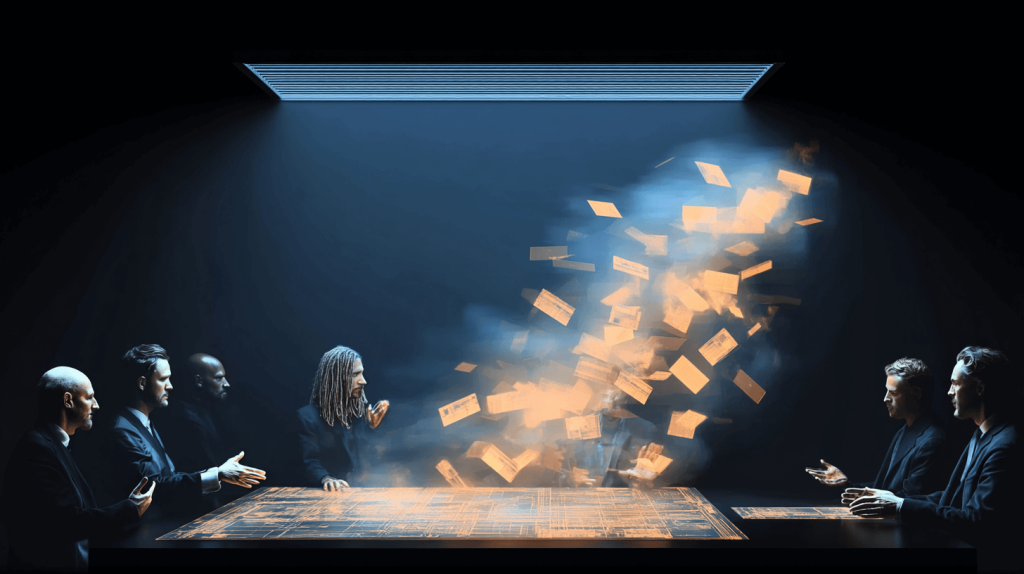Would you be surprised if I told you most businesses don’t understand their own value? Sure, some companies can rattle off their annual sales, profits after expenses, or monthly recurring revenue, but what about the intangible property not shown on the balance sheets or easily calculable. While most businesses are focused on sales and scaling outbound activity, it can be said the riches are often hidden within your own walls.
If you are a business owner and are not thinking of ways that you can acquire long terms assets within your own company, then I would ask you to take a moment and estimate what you believe the value of your company would be worth if you were the exclusive owner of the market leading technology.
What if you were the only business that held the exclusive rights to a proprietary software, Fintech, Artificial Intelligence, Mobile App brand, or social media platform? At the same time, what you if you didn’t protect your proprietary assets and they were lost or stolen – how do you calculate that scenario? Do you ever wonder how much more you could grow if you were able to license your intangible property and intellectual property to a third party and collect royalties?
In a rapidly evolving global market driven by continuous innovation, the concept of property has transcended physical boundaries and can often be found in the unseen. Intangible property, often referred to as invisible assets, constitutes a distinct realm within the spectrum of assets that may not be held in your hand but provide financial value to your company. Intangible property cannot be seen and have no physical form, they are not generally recorded in your balance sheet, but are invisible assets that accrue value over time and can be considered indefinite once created or acquired.
Most businesses don’t understand the value of their own intangible property or how to create a strategy that will help you to monetize those assets. Unfortunately, many businesses will continue to only focus on the short-term revenue and growth and will not take advantage of the hidden treasures found within their own company. These businesses will continue to trip over the hidden dollars to pick up a few dimes. However, those companies who invest in building a long-term strategy and have the discipline to execute those strategies will experience long-term growth by building and acquiring their intangible assets and intellectual property.
In this article we delve into the intricate world of intangible property and intellectual property, deciphering its legal definitions, contrasting it with tangible assets by presenting examples and emphasizing the importance of long-term strategic thinking.
The Legal Definition of an Intangible Asset
The definition of intangible property is simple: its a non-monetary asset that lacks any physical structure but has financial value The world of intangible assets constitutes hidden resources in your business landscape, encompassing a diverse array of values and rights that lack a physical presence but can provide your business hidden value.
Intangible vs. Tangible Assets: What’s the Difference?
Understanding the differentiation between intangible and tangible assets is essential for comprehending their value and potential. A resource from the Business Development Bank of Canada (BDC) outlines the fundamental disparities between these two asset categories. Tangible assets possess physical presence, encompassing items such as buildings, equipment, and inventory that are easily appraised and viewable on a balance sheet. Conversely, intangible assets derive their value from legal rights or intellectual property, including patents, copyrights, trademarks, and trade secrets where value is measured from licensing, research and development, and brand recognition.
Examples of Intangible Property
One example of intangible property is found in intellectual property such as patents, trademark, and copyrights. However, most business don’t realize their proprietary software, reputation, brand recognition, customer loyalty and goodwill are considered intangible assets that add value to a company’s bottom line during acquisitions.
While many software companies generally use the “rule of 10” (i.e., the net income multiplied by 10) when deriving sales price, there is often money “left on the table” when intangible assets are not factored into the price. When a company is pre-revenue or has not offered internal share sales, the valuation process can often get blurry. However, the calculation of intangible assets doesn’t require profit-to-earning ratios, the value of similar transactions, or internal sale factors to define.
One example of the difficulty in calculating the value of intangible assets is goodwill. What is the value of a company’s goodwill and how to do you estimate the value of goodwill or customer loyalty. While you may try and calculate goodwill as the difference between what a company pays to purchase another and the market value of the purchased company assets, what happens when the company goodwill becomes “impaired” or “spoiled” or lags in the market.
Examples of Tangible Property
To gain an understanding of intangible property, it’s essential to juxtapose it with its tangible counterpart. As highlighted by Investopedia, tangible personal property includes physical items such as vehicles, furniture, equipment, and machinery where the value can easily be calculated by computing the cost of the asset minus depreciation. While tangible property is perceivable and concrete, the opposite can be said for intangible assets.
Types of Intangible Property
The umbrella of intangible property encompasses a broad spectrum of assets, classified into four primary categories:
1. Intellectual Property: This category encompasses patents, trademarks, copyrights, and trade secrets.
2. Digital Assets: Within the realm of digital assets, one finds entities like domain names, digital currencies, and non-fungible tokens (NFTs).
3. Goodwill: An intangible asset, goodwill, represents the positive reputation and associations that a business holds in the eyes of its clientele.
4. Contracts and Agreements: Legal agreements, contracts, and licenses contribute to this category, each carrying substantial value.
Intellectual Property Assets
The sphere of intellectual property (IP) assets stands as a cornerstone within intangible property. Understanding what form of intellectual property is right for your business may not be easy and often you must factor the goods or services you sell, the industry you service, and your future research and development. However, we have put together some thoughts every business should consider when monetizing and protecting their intellectual property.
Patents
Patents are often the debated forms of intellectual property that protect new, novel, and useful machines, processes, software, and designs. There are both utility patents that protect functionality, and design patents that protect the non-functional ornamental design of a product.
Patents can be a critical asset for any business as it provides a competitive advantage over other companies in the same marketplace, attract investment opportunities and funding, and provide both short and long-term monetization strategies through licensing and acquisitor. If you are SaaS or Tech company that has created software, artificial intelligence, machine learning, mobile apps, or other proprietary products a patent may be your greatest intangible asset.
Trademarks
Trademarks function as safeguards for a brand’s identity, preventing the unauthorized use of similar marks that might confuse consumers. Trademarks are symbols, names, or logo’ that are either federally registered with the United States Patent and Trademark Office or acquired through use in commerce. Some everyday examples include Apple’s Apple Logo on products like the MacBook, iPhone, and iPad, McDonalds Golden Arches and Mercedes-Benz’s Three-Pointed Star. Every business should consider a trademark for their company name, logo, products and/or services.
The intangible value of a trademark is easy to understand as its the brand recognition that is immediately created in the mind of a consumers by looking at a trademarked name, logo, or slogan without having to view the individual products. However, this form of intangible property is not easily calculable. For example, while it may be estimated the Coca-Cola mark is worth more than 10 billion dollars, there is no exact equation to calculate its value.
Copyrights
Copyrights are a form of intangible property that are created the moment the eligible work is affixed into a tangible medium. While most people recognize a copyright as the warning they read at the beginning of movie, television production, computer software, or book, most don’t realize the value that a single copyright may create for your business. The owner of a copyrighted work may reproduce, perform, display, and distribute their creations.
However, it’s important to understand that a copyright does not protect and idea or concept, but rather protects the non-functional expression of those ideas. Registration of a copyright provides legal remedies such as monetary and injunctive relief against an infringing party who makes, uses, reproduces, perform, or displays a copyrighted work without the copyright holder’s authorization. If you produce original content, are you a social media influencer, produce video or music, create artwork or sell software – then a copyright is a “must” for your business.
Trade Secrets
Trade secrets encompass confidential business information that confers a competitive edge on a specific business such as confidential business practice, customer lists, formulas, compositions, and designs. The value of the trade secret come from the fact that is not publicly known or readily available. However, companies must take the proper steps to ensure they maintain their trade secrets and have taken reasonable steps to safeguard those secrets such as requiring all employees and contractors to sign comprehensive non-disclosure agreement. Remember the value of trade secret and the protections afforded to it are lost once revealed in the public domain.
Digital Assets
For many startups and software companies, digital assets can be a valuable form of intangible property. Digital assets can be either tangible or intangible property and are broadly defined as any text or media that is formatted into a binary source and are most often digital documents, audio and visual content, blockchain tokens, or digital files stored in a computing or mobile computing device. Prominent examples of intangible digital assets include:
Domain Name serve as a valuable intangible property and acts like a “street map” for your IP address, symbolizing a brand’s digital identity and online presence. Most don’t realize that a domain name is more than just a string of text that a user types into their browser to find your webpage, it can be hidden digital asset that can be bought and sold for millions of dollars. Did you know that the voice.com domain name sold for over $30 million dollar in 2019? Other popular monetization strategies for domain names include licensing, domain flipping, domain parking, and affiliate and direct marketing.
Digital Currencies: is a popular form of currency that is available in digital and electronic form. Most people think of cryptocurrencies such as like Bitcoin, Ethereum, and Dogecoin that are popular decentralized digital currencies that use algorithms to ensure secure transactions through the blockchain. However, E-Money which of often one of the most overlooked forms of intangible assets is transacted millions of times every day through popular mobile apps like PayPal, and Venmo.
Non-Fungible Tokens (NFTs): NFTs are more than just the “Bored Ape Yacht Club” or “ON1 Force” and represent unique digital assets symbolizing ownership of specific content or items, commonly utilized in art and entertainment sectors. NFT can be bought and sold through a Digital Wallet or on popular NFT marketplaces such as OpenSea, Rarible, and Foundation using Ethereum.
Are Money and Stocks Intangible Property?
While money and stocks might not conventionally be deemed intangible property, they do exhibit intangible attributes when converted into a digital asset. While physical currency, stock certificate, and crypto tokens are characterized as tangible assets, what happens when they are used to purchase an intangible asset such as a cryptocurrency?
Most companies are not ready to transact business with digital currencies or fully understand how to, but they are familiar with stock certificates which if a physical finished good may be considered a tangible asset. At the same time, if that same stock is not a certificate and stored in a safety deposition box but is only bought and traded and through an exchange may be considered intangible.
Don’t understand the value of digital currencies. While events like the 2018 Crypto Winter and 2021 Correction saw the price of popular cryptocurrencies like Bitcoin collapse and have given crypto a “black eye”, one value of these digital currencies are that they are not subject to market fluctuations such as inflation that regularly de-value currencies.
Why Speaking to an IP Attorney Could Be the Best Investment for Your Intangible Assets
There is no doubt in today’s marketplace that intangible assets and intellectual property constitutes the foundation of modern business, offering both short- and long-term appreciation for business who may monetize them through licensing or acquisition. From intellectual property rights to digital assets, these concealed treasures wield a pivotal role in shaping the trajectory and success of your business and knowing where to look is the first step.
The Rapacke Law Group is a fixed fee (no billable hour) patent and intellectual property firm designed for software and technology companies looking to protect their most valuable intellectual property assets. Our firm provides one transparent fixed fee for all patent and trademark matters without the hassle of surprise costs or nickel-and-dime billing used by traditional law firms.
The RLG Guarantee
In addition to a fixed-fee billing approach, RLG offers a money-back guarantee on all prior art searches, trademark applications, provisional patent applications, and design patent applications. To be clear: should our team determine that your invention is not patentable in light of the prior art, a full refund will be provided. If patentable, we will credit the cost of your search towards your new application.
For the trademark and design patent applications, this means that if your application does not receive a notice of allowance for any reason, we will provide a full refund. Our trademark and design patent application packages include all search, preparation, office action, USPTO correspondence and filing fees. Please call us at (954) 951-0154 for a free consultation or take our intelligent IP quiz to see what protection is best for your invention.
Ready to take the next step? Schedule a free IP Strategy Call now.




